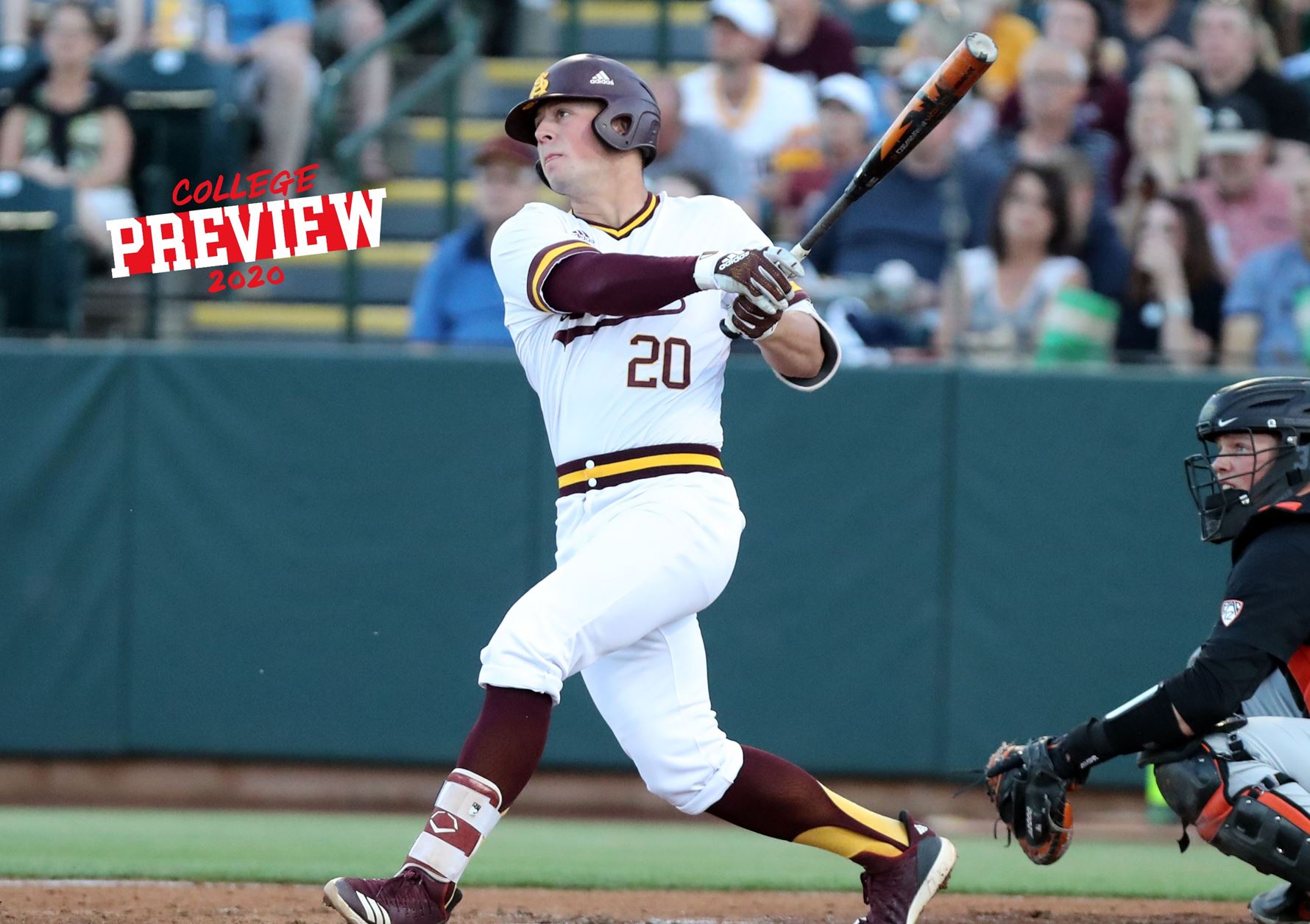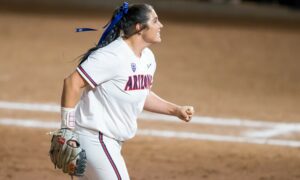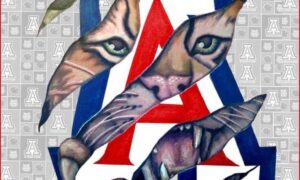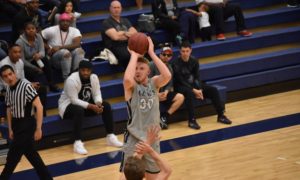By Joe Healy Baseball America
Last season, the Pac-12 got five teams in the NCAA tournament: one truly elite team (UCLA) and two excellent teams that also hosted (Stanford and Oregon State). But come time for the College World Series, the league came up empty.
In 2020, the chances of it having another elite team are good. Arizona State comes into the season ranked No. 3, led by one of the best offenses in college baseball, and UCLA comes in at No. 10. Arizona is the third team in the Preseason Top 25, ranked No. 22.
With several teams in the league undergoing some rebuilding and several others having recently made a coaching change, the middle portion of the league standings are particularly difficult to predict this time around.
Preseason Awards
Player of the Year: Spencer Torkelson, 1B, Arizona State
It would be tough to be more productive than Torkelson has been at ASU. Over his two seasons, he has a .337/.443/.723 slash line with 29 doubles, 48 home runs and 119 RBI, and a whole host of awards, including Pac-12 freshman of the year in 2018 and back-to-back All-American honors. He’ll come into the season among the favorites to be taken first overall in the draft, and as the most important piece in a Sun Devils lineup that hopes to lead the team to its first national title since 1981.
Pitcher of the Year: Brendan Beck, RHP, Stanford
Beck, the brother of former Stanford ace Tristan Beck, enjoyed a solid freshman season in 2018, going 8-0 with a 2.43 ERA and a .225 opponent batting average in 66.2 innings. Last season, he emerged as a workhorse in the rotation, throwing a team-high 91.2 innings and went 5-4, 3.63. With Alex Williams, whose freshman season in 2019 was reminiscent of Beck’s, the veteran righthander will lead what should once again be a Cardinal rotation good enough to give the team a chance to win every weekend series.
Freshman of the Year: Cooper Benson, LHP, Arizona State
What promises to set apart the 2020 Arizona State team is the quality depth on the pitching staff that was missing last season when the Sun Devils got to a regional but came up short of the regional final. Among all of that depth, Benson has already made a name for himself. His raw stuff may not jump off the page just yet, but his competitive nature does. ASU coach Tracy Smith notes that Benson believes that he’s going to get every hitter out each time he steps on the mound, and for a freshman in a major conference, that’s huge.
Predicted Order of Finish (2019 record)
1. Arizona State (38-19, 16-13)
Last season, Arizona State was clearly a good team. It started the season 21-0 and its offense was good enough to keep the team in most games, but they were a bit short on the mound. This year could be a different story. With first baseman Spencer Torkelson (.351/.446/.707), shortstop Alika Williams (.333/.429/.474), third baseman Gage Workman (.330/.413/.528) and outfielder Trevor Hauver (.339/.433/.574) back in the lineup, the offense will be potent again, and Williams, Workman, second baseman Drew Swift (.265/.375/.333) and catcher Sam Ferri (.269/.321/.385) give ASU outstanding defensive potential as well.
The pitching talent and depth is on another level in 2020. Righthander Boyd Vander Kooi (4-4, 5.59) returns after throwing 95 innings as a member of the rotation last year, but he’s surrounded by highly-talented new faces in junior college transfer Justin Fall, a lefthander with electric stuff, freshman Cooper Benson, and Saint Mary’s transfer Tyler Thornton (10-2, 2.71), who was a Freshman All-American last season. in the bullpen, closer RJ Dabovich (4.75, 3 SV) is back after an outstanding summer on the Cape, as is lefthander Erik Tolman (3-1, 3.38), who held opponents to a .206 average in 48 innings in 2019. ASU is a complete team and a real contender to win the national title.
2. UCLA (52-11, 24-5)
Even with the loss of two-thirds of its weekend rotation in Ryan Garcia and Jack Ralston, UCLA should still pitch well in 2020. Righthander Zach Pettway (2-2, 4.55) is a veteran presence at the front of the rotation, and sophomore righthander Nick Nastrini (1-0, 1.37) should fit nicely behind him on Saturdays after a standout summer on the Cape. You will also be hard pressed to find a bullpen duo better than righthanders Holden Powell (1.84, 17 SV) and Kyle Mora (2.09, 1 SV). Offensively, there are more questions, what with the departures of Michael Toglia, Chase Strumpf, Ryan Kreidler, Jack Stronach and Jake Pries, but there is plenty of potential. Preseason All-American outfielder Garrett Mitchell (.349/.418/.566) is a bonafide star already, the middle infield duo of shortstop Matt McLain (.203/.276/.355) and second baseman Kevin Kendall (.258/.331/.298) very well could join him in those ranks in 2020 and catcher Noah Cardenas hit .375/.476/.500 in 136 at-bats last season. The pitching staff alone will keep the Bruins competitive at the top of the Pac-12, and if the offense takes a step forward, they could make a run at ASU for the league title.
3. Arizona (32-24, 15-14)
The Wildcats are ranked in the preseason in large part because they have the only offense in the league that can, at least on paper, match up well with Arizona State’s. Matthew Dyer (.393/.480/.571), Austin Wells (.353/.462/.552) and Dayton Dooney (.323/.417/.596) are all back after massive seasons a year ago, although where those three play in the field is a question that will continue into the season. Outfielder Ryan Holgate hit just .240/.378/.437 last year, but he showed power and could be ready for a star turn in 2020. The same is true of Donta Williams (.267/.396/.408), who gives the Wildcats an established elite defender in the outfield. First baseman Branden Boissiere (.336/.430/.464) and third baseman Tony Bullard (.301/.412/.482) shined in part-time roles and will look to take that success into full-time gigs this season. The question is what Arizona can expect on the mound. Top reliever Vince Vannelle (3.47, 2 SV) and projected Friday starter Quinn Flanagan (8-3, 4.92) return, but it’s nothing but new faces in the major roles around that pair. If new pitching coach Nate Yeskie, one of the brightest pitching minds in college baseball, can bring along the staff quickly, Arizona’s ceiling is significant.
4. Stanford (45-14, 22-7)
After earning a spot as a host last season and coming in second in the Pac-12 standings, the expectation is that Stanford will take a bit of a step back this season. Just nine lettermen return from that highly-successful 2019 squad, with much of the roster turnover concentrated in the lineup. The top five hitters for average are gone, as are the top four home run hitters. Still, there are plenty of reasons for optimism, namely, a weekend rotation led by Brendan Beck (5-4, 3.63) and Alex Williams (8-1, 2.56), two accomplished arms that will help mitigate the loss of Erik Miller, and relievers Zach Grech (3.68, 1 SV) and Jacob Palisch (5-2, 4.79), who will do the same for the loss of closer Jack Little. Offensively, the versatile Tim Tawa (.253/.284/.410), who could see time at shortstop and center field for the Cardinal this season, will likely make the team go. He’ll be supported by the likes of outfielder Christian Robinson (.287/.386/.370), who showed well in a part-time role a season ago, and highly-touted freshmen Henry Gargus and Brock Jones. The talent on the pitching staff will keep the floor high for this Stanford team. If the new pieces on offense come together quickly, it will raise the ceiling for what they can accomplish.
5. California (32-20, 17-11)
Even with the departure of Andrew Vaughn, to say nothing of the loss of catcher Korey Lee and shortstop Cameron Eden, the Bears have the talent to make back-to-back postseason appearances for the first time since 2010-11. Second baseman Darren Baker (.306/.367/.335), third baseman Quentin Selma (.311/.366/.584), outfielder Max Flower (.280/.345/.407) and first baseman Grant Holman (.272/.362/.456) lead a veteran lineup also filled with experienced players moving from part-time roles to full-time gigs. Losing Jared Horn and Arman Sabouri will also be tough to overcome, but a rotation made up of Sam Stoutenborough (8-5, 4.52), Sean Sullivan (2-1, 5.88) and the two-way player Holman (3-3, 4.82) will keep the ceiling for the pitching staff fairly high. Other than Horn, every pitcher on the Bears roster threw in multiple roles last season, so expect some mixing and matching as the 2020 season rolls on.
6. Oregon State (36-20-1, 21-8)
It’s a season of change in Corvallis. Mitch Canham, Oregon State’s catcher on its 2005-06 national championship teams, was hired as coach in June. It was a surprising move, as Canham, 35, was managing in Double-A and regarded as a rising star in pro ball. Instead, he returns to his alma mater and will have to deal with significant on-field turnover as well. The biggest hole was left by Adley Rutschman, who last year was the No. 1 overall draft pick and College Player of the Year, though the Beavers also must account for shortstop Beau Phillip and righthander Bryce Fehmel. Replacing Rutschman might be an impossible task to fully replace what Rutschman brought, but fortunately for the Beavers, they do return a number of experienced players in the lineup that will help in this regard. They include catcher Troy Claunch (.264/.333/.347), utility man Alex McGarry (.293/.401/.478), infielder Ryan Ober (.266/.371/.392), outfielder Joe Casey (.254/.347/.400) and outfielder Preston Jones (.228/.338/.325). Look for Oregon State to pitch well again in 2020, thanks in large part to the return of lefthanders Jake Mulholland (1.93, 8 SV) and Christian Chamberlain (3.83, 2 SV), who have primarily pitched out of the bullpen in the past. One big question mark is the availability of Kevin Abel, who could make a return to the mound late in the season after missing much of 2019 due to Tommy John surgery. With a severe lack of proven starting pitchers back, Abel’s return, even if he’s not the pitcher he was in the CWS in 2018, would be a boon for the Beavers.
7. Washington (28-24, 12-17)
The 2020 season could be a bounce back year for Washington after it wasn’t able to follow up its Omaha trip in 2018 the way it wanted to. An intriguing group of position players return, chief among them second baseman Braiden Ward (.321/.412/.446), who provides an exciting mix of on-base ability and speed. Of UW’s 41 stolen bases in 2019, Ward had 26. First baseman Jonathan Schiffer (.250/.352/.342) and outfielder Christian Jones (.100/.100/.200) will look to bounce back from injury-plagued seasons to be the durable players they were during the CWS run. Catcher Michael Petrie (.275/.431/.314) showed impressive on-base ability in a part-time role last season and will look to do so full-time in 2020, and shortstop Ramon Bramasco (.284/.383/.351) is back as a steady hand. The UW lineup also features three new faces, two junior college transfers in third baseman Tommy Williams and outfielder Davis Delorefice, and highly-touted freshman outfielder Will Simpson. In the rotation, two converted relievers in righthander Stevie Emanuels (2-3, 2.35) and righthander Jack Enger (3-0, 3.20), around returning starter David Rhodes (5-6, 4.84), hold the key to the Huskies putting together a staff that can compete within the Pac-12.
8. Southern California (25-29-1, 13-15-1)
The individual talent on the roster makes Southern California’s 2020 ceiling much higher than you might expect for a team with a new head coach, former Loyola Marymount skipper Jason Gill, that is also coming off of a sub-.500 season. If things come together in the starting rotation, it could be one of the best in the league. Righthander Kyle Hurt (3-7, 5.69) may not have put up the numbers he hoped for last season, but there’s little doubting that he has the talent to be a Pac-12 pitcher of the year-type arm. Lefthanders John Beller (2-2, 3.86) and Isaac Esqueda (3-5, 3.94) are good veteran options in the rotation and are coming off good summers in the Cape Cod League. A key addition in the bullpen is grad transfer Ben Wanger, who was a first-team All-Ivy League performer in 2018, which should help offset the loss of relief ace Chris Clarke. There are more questions in the lineup after the departures of outfielder Matthew Acosta, catcher C.J. Stubbs and outfielder Blake Sabol, but the return of high-end talents like third baseman Jamal O’Guinn (.281/.401/.452) and shortstop Ben Ramirez (.273/.318/.344) give the position player group some upside.
9. Oregon (27-29, 10-19)
Much of Oregon’s success in 2020 under new coach Mark Wasikowski hinges on the health of two-way player Kenyon Yovan. In 2018, he was one of the best pitchers in the Pac-12, with a 2.98 ERA and 98 strikeouts in 84.2 innings, but last season, he was limited to just one appearance by injury. He goes into the season healthy, and if he stays on the field, a one-two punch of he and lefthander Robbie Ahlstrom (5-7, 3.93) will keep the Ducks competitive on the weekend. Righthander Cullen Kafka (5-5, 5.48) will likely transition back to a role in the bullpen after serving in the rotation in 2019. Senior first baseman Gabe Matthews (.290/.404/.440), a power bat who also plays excellent defense, outfielder Tanner Smith (.284/.372/.423) and second baseman Sam Novitske (.300/.401/.343) will look to carry the load again offensively.
10. Utah (16-33, 6-24)
The Utes return a veteran lineup highlighted by senior catcher Zack Moeller (.264/.378/.408), who also plays his position well, junior first baseman Shea Kramer (.279/.345/.347) and junior third baseman Rykker Tom (.279/.365/.355). New pitching coach Gary Henderson comes to Salt Lake City with an impressive list of accomplishments, both as a pitching coach and head coach. In year one with Utah, he will have some experience to work with in the rotation with the return of David Watson (2-0, 6.25), Riley Pierce (1-7, 7.04), Kyle Robeniol (1-4, 4.91) and Dustyn Schramm (2-4, 5.10). Watson stands out for the jump he made over the summer, which convinced the coaching staff that he is ready to be a Friday starter in the league. Utah feels a long way off from where they were in 2016, when it won the regular season championship, but this is a veteran team that should help the Utes make a move back in the right direction.
11. Washington State (11-42-1, 3-26-1)
In the long term, new head coach Brian Green will look to do at Washington State what he did at New Mexico State, when an 11-38-1 record in his first season became a 34-23 record in year two. In the short term, he will look for players that can make up the foundation for future years. Plenty of experienced starting pitching options return in lefthander A.J. Block (0-8, 6.06), righthander Brandon White (2-8, 6.52), righthander Zane Mills (2-4, 5.25), who is transitioning from the bullpen, and Hayden Rosenkrantz (2-4, 5.34). Outfielder Collin Montez (.286/.377/.432) and first baseman Kyle Manzardo (.272/.335/.364) are the leading returners in a lineup that will also feature a number of new faces, including freshman outfielder Nathan Swarts, who Green describes as the best athlete on the team.
Top 2020 Draft Prospects
- Spencer Torkelson, 1B, Arizona State
- Garrett Mitchell, OF, UCLA
- Austin Wells, C, Arizona
- Alika Williams, SS, Arizona State
- Gage Workman, 3B, Arizona State
- Kevin Abel, RHP, Oregon State
- Justin Fall, LHP, Arizona State
- RJ Dabovich, RHP, Arizona State
- Trevor Hauver, OF, Arizona State
- Jamal O’Guinn, 3B, Southern California
- Jacob Palisch, LHP, Stanford
- Brendan Beck, RHP, Stanford
- Tim Tawa, SS/OF, Stanford
- Braiden Ward, 2B, Washington
- Boyd Vander Kooi, RHP, Arizona State
- Darren Baker, 2B, California
- Holden Powell, RHP, UCLA
- Ben Ramirez, SS, Southern California
- Stevie Emanuels, RHP, Washington
- Chandler Champlain, RHP, Southern California
Top 2020 Prospects
- Matt McLain, SS, UCLA
- Tyler Thornton, RHP, Arizona State
- Noah Cardenas, C, UCLA
- Sean Sullivan, RHP, California
- Nick Nastrini, RHP, UCLA
- J.T. Schwartz, 1B, UCLA
- Ryan Holgate, OF, Arizona
- Tony Bullard, 3B, Arizona
- Seth Tomczak, RHP, Arizona State
- Alex Williams, RHP, Stanford
Top Newcomers
- Justin Fall, LHP, Arizona State
- Michael Curialle, SS, UCLA
- Cooper Benson, LHP, Arizona State
- Seth Tomczak, RHP, Arizona State
- Garrett Irvin, LHP, Arizona
- Henry Gargus, 1B/OF, Stanford
- Emanuel Dean, OF, UCLA
- Nate Weeldreyer, RHP, Washington
- Dawson Netz, RHP, Arizona
- Chandler Murphy, RHP, Arizona
Best Tools
Best Pure Hitter: Spencer Torkelson, Arizona State
Best Power Hitter: Spencer Torkelson, Arizona State
Best Strike-Zone Discipline: Austin Wells, Arizona
Best Athlete: Garrett Mitchell, UCLA
Fastest Runner: Braiden Ward, Washington
Best Baserunner: Darren Baker, California
Best Defensive Catcher: Noah Cardenas, UCLA
Best Defensive Infielder: Alika Williams, Arizona State
Best Infield Arm: Gage Workman, Arizona State
Best Defensive Outfielder: Donta Williams, Arizona
Best Outfield Arm: Donta Williams, Arizona
Best Fastball: Kyle Hurt, Southern California
Best Breaking Ball: Holden Powell, UCLA
Best Changeup: Zach Pettway, UCLA
Best Control: Brendan Beck, Stanford
















